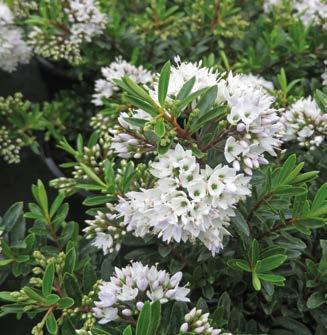
20 minute read
Gardening Trends - Wildlife

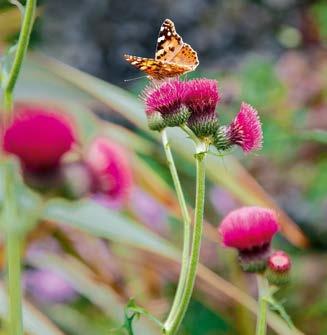
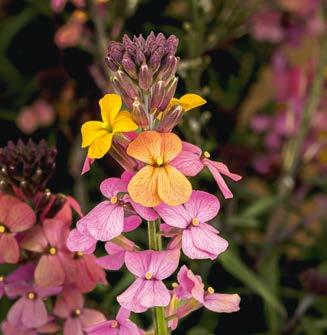

Squire’s Garden Centres has revealed their top three gardening trends for 2020, gardening for wildlife, wellbeing, and the world.

1. Gardening for Wildlife Growing plants as a nectar and food source for wildlife encourages native birds and insects to thrive and increase.
Sarah Squire, Chairman of Squire’s Garden Centres, commented, “The more the built environment expands the more vital our gardens become. What is more, gardening for wildlife can also create magical spaces for humans. There is an undoubted trend towards plants that encourage wildlife and it is our job to help gardeners recognise them.”



Plants for Wildlife - (clockwise from top left) Hebe ‘Celine’, Lavender ‘Melissa’, Cirsium rivulare ‘Atropurpureum’, Eyrsimum ‘Super Bowl Sunset’



Combine different flower shapes and varied flowering times to produce a good supply of pollen and nectar for wildlife from spring through to autumn.
Some great plants for wildlife include: • Hebe ‘Celine’ – an evergreen shrub with white flowers from April to June • Lavender ‘Melissa’ – highly fragrant flowers from June to August • Cirsium rivulare ‘Atropurpureum’ – a prickle-free thistle that flowers from June to September. • Eyrsimum ‘Super Bowl Sunset’ – a new variety of wallflower which blooms from April to September
2. Gardening for Wellbeing. Increased emphasis on mental, as well as physical health has highlighted the proven benefits of being outside and reconnecting with nature. Gardening is a great way to disconnect from screens and find some genuine reality. Sarah Squire added, “Gardening is creative - you plant your own canvas. White flowering plants remain very popular, but a lot of fun can be had with colour in the garden so don’t rule anything out. It is your garden and should reflect your own tastes and personality.”
White plants
• Choisya ‘Greenfingers’ - glossy evergreen leaves & scented summer flowers Clematis Montana ‘Miss Christine’ – fragrant white flowers from May - June
Bold & Bright plants
• Rosa ‘For You With Love’ – repeat flowering bush rose, lightly scented Clematis ‘Meghan’ – named after the Duchess of Sussex it flowers from May to June and again in September
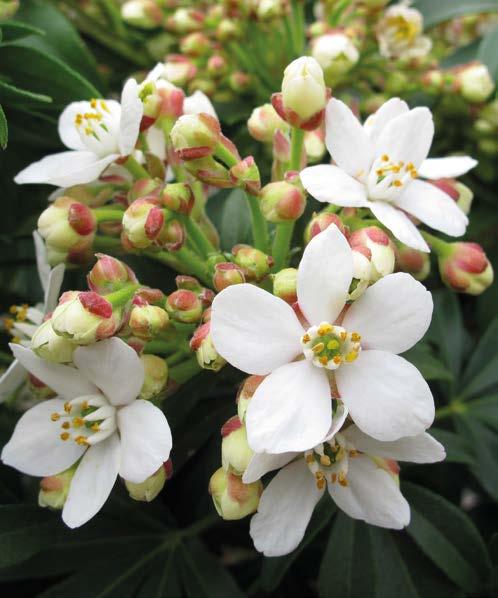



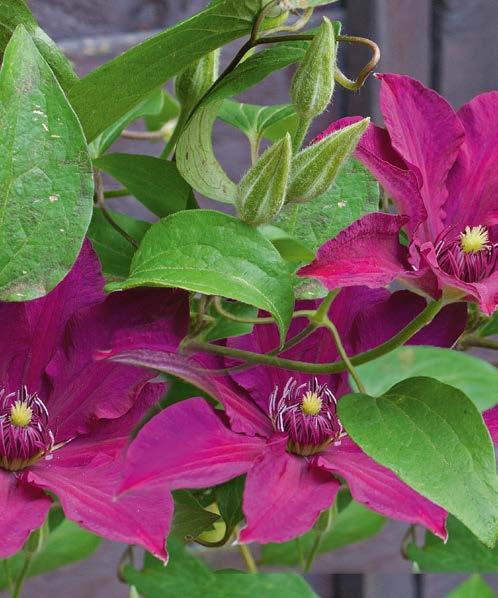

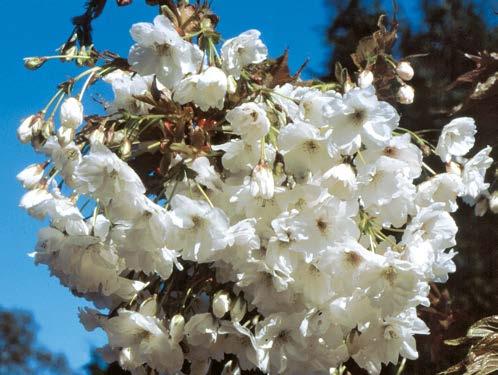
White & Bright Plants for Wellbeing - (clockwise from top left) Choisya ‘Greenfingers’, Clematis Montana ‘Miss Christine’, Rosa ‘For You With Love’, Clematis ‘Meghan’
3. Gardening for the World. “Gardeners are among some of the most environmentally conscious people I know, always on the lookout for green alternatives, committed composters and totally invested in doing their bit.” said Sarah Squire. “And the industry is working hard to make sure plant pots are made of recycled material, which can in its turn be recycled.”
She added, “Britain has some of the best nursery growers in the world and you may be surprised just how many plants in your local garden centre are grown in the UK, many very locally indeed, thus reducing plant miles. If there is one thing I think we could all do for our world fairly easily it is plant a tree. Trees







Trees for the World - (clockwise from top) Acer, Flowering Cherry Prunus ‘Beni-yutaka’ and Prunus ‘Fragrant Cloud’
are fantastic as a habitat and food source for wildlife and as a source of carbon capture. They also give structure and architecture to a garden.”
There are trees for every size and shape of garden, from a small acer in a pot on a balcony or a gorgeous flowering cherry in a back garden, to birch, whitebeam and hornbeam for larger spaces. Plant one today and make our world a better place.
RIGBY TAYLOR’S EUROFLOR URBAN MEADOW FLOWERS ADD THE SPARK TO ELECTRICITY NORTH WEST’S SUBSTATION REVAMP

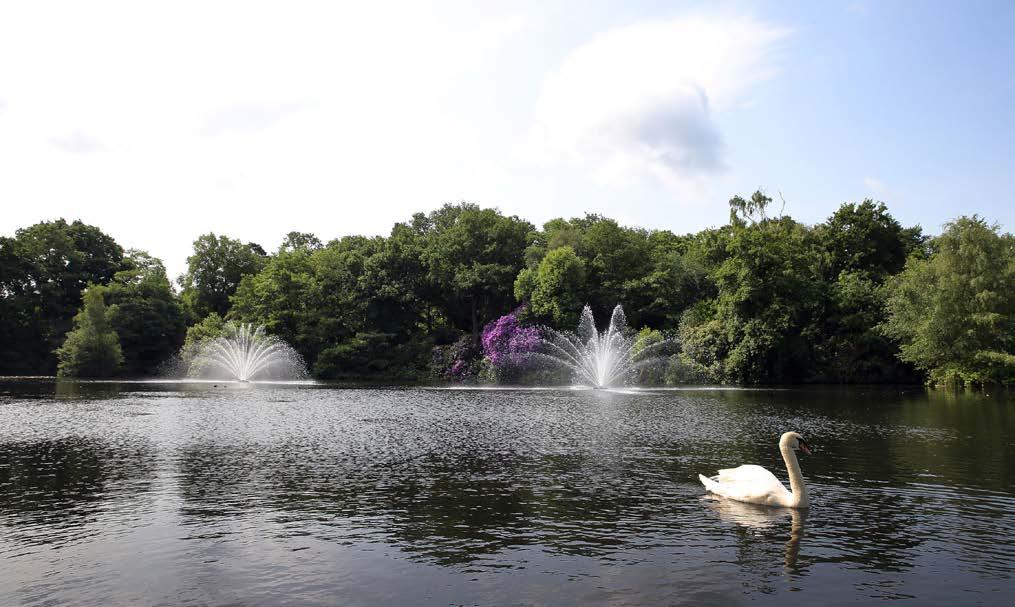
Rigby Taylor’s Euroflor urban meadow flower seed mixes have played a key role in the success of Electricity North West’s ‘Transforming our Spaces’ project by revamping substations throughout the region with spectacular displays of colour from flower mixes that also attract a host of pollinators.
The colourful displays produced by the Euroflor seed mixes (from Top Green, the largest seed producer in Europe) also drew laudatory comments from the local communities as well as council officials and MPs.
For example, commenting on one site, Copeland MP Trudy Harrison said: “Electricity North West has planted what was previously grassland, requiring regular and costly maintenance, into a beautiful and environmentally beneficial wildflower oasis…This is an economic, environmental and social win, win, win project which should be replicated all over the UK.” Angie Thornton, Electricity North West’s Groundworks Delivery Manager, who is heading up the scheme, said: “We are all absolutely delighted with the results; the sites truly have been transformed from what used to be eyesores into beautifully vibrant areas for the local communities to take pride in and spaces for revitalising insects and wildlife.
“Substations aren’t always aesthetically pleasing but they are a key part of the electricity network. The project has been extremely well received by the communities and residents are keen to get involved and replant flowers in the future.”
Eight substations were initially targeted last year and working closely with Rigby Taylor, an established supplier of amenity supplies to the electricity board (supplying the Icade, Chikara and Gallup Biograde herbicides, for example), various Euroflor urban meadow flower mixes were selected. These included Rainbow Perennials and Flora Britannica from Euroflor’s Project Pollin-8 range specifically designed to attract pollinators while also delivering high visual impact. The displays lasted through the summer and into October and November.
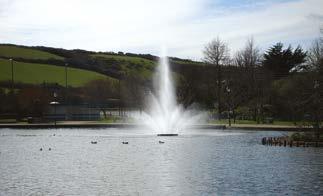
Howard Wood, Top Green’s Euroflor consultant, presented classroom and on-site workshops to help guide the grounds staff in the preparation and maintenance of the flower beds, which in some cases also utilised the ‘lay down and plant’ FloraFleece biodegradable matting Euroflor option, which eliminates the need for extensive soil preparation. Bird feeders and bug hotels were also installed in some cases.
Electricity North West’s ‘Transforming our Spaces’ project will return this year with the continued support from Rigby Taylor.

GIANT RESULTS WITH OTTERBINE’S GIANT FOUNTAINS

Otterbine’s line of giant fountains is the go-to for landscape architects, designers and contractors wanting a dramatic focus for their landscaping and commercial projects, providing a sensational display wherever they’re used.
From the staggering 90ft or 27m height of the Supernova to the magnificent multi-dimensional cascading pattern of the Equinox, onlookers never fail to be impressed by any of the seven in the range.
The Equinox and Aries have the lowest spray height, but they more than make up for that in their width, spreading their cascading patterns up to 121ft across the diameter of the lake. The Triad and Aquastar have height and a good fan pattern, while the Polaris has a rich and dense water flow effect and the Mystic and Supernova go up and up!
It’s not just about the fountain’s aesthetic though, Otterbine complementary aeration systems offer the highest oxygen transfer and pumping rates in the industry, independent testing done by the University of Minnesota and GSEE prove it. They add as much as 3.3lbs or 1.5kg of oxygen per horsepower hour into the water and can pump over 920GPM or 199m3/ hr per horsepower, which means that they’re as impressive in their functionality as they are in their appearance.
Constructed for ease of use, this line allows for shallow operating depths of only 40ins or 1m, while large wheels on the frame improve mobility and eliminate the need for hoists and cranes during installation in most instances.
Combine this with corrosion resistant materials (they’re manufactured with 316 marinegrade stainless steel, one of the highest on the market), a unique screening system to simplify cleaning and an adjustable float to minimise visibility in the water – these units are virtually maintenance free!

With an average lifespan of over 15 years and backed by an allinclusive four-year warranty (five years if adding Franklin’s Sub-trol monitor), Otterbine systems are built to last and are energy efficient. Their beauty can be added to and prolonged with the addition of a Fountain Glo light system, from the energy efficient LED lights to colourchanging RGBW sequencing light systems, giant results with Otterbine aren’t limited to daytime only, but night-time too.
Find out how to take your venue’s outdoor space to new heights with Otterbine by visiting distributor Reesink Turfcare at reesinkturfcare.co.uk

RETROFITTING PERMEABLE PAVING FOR SUDS
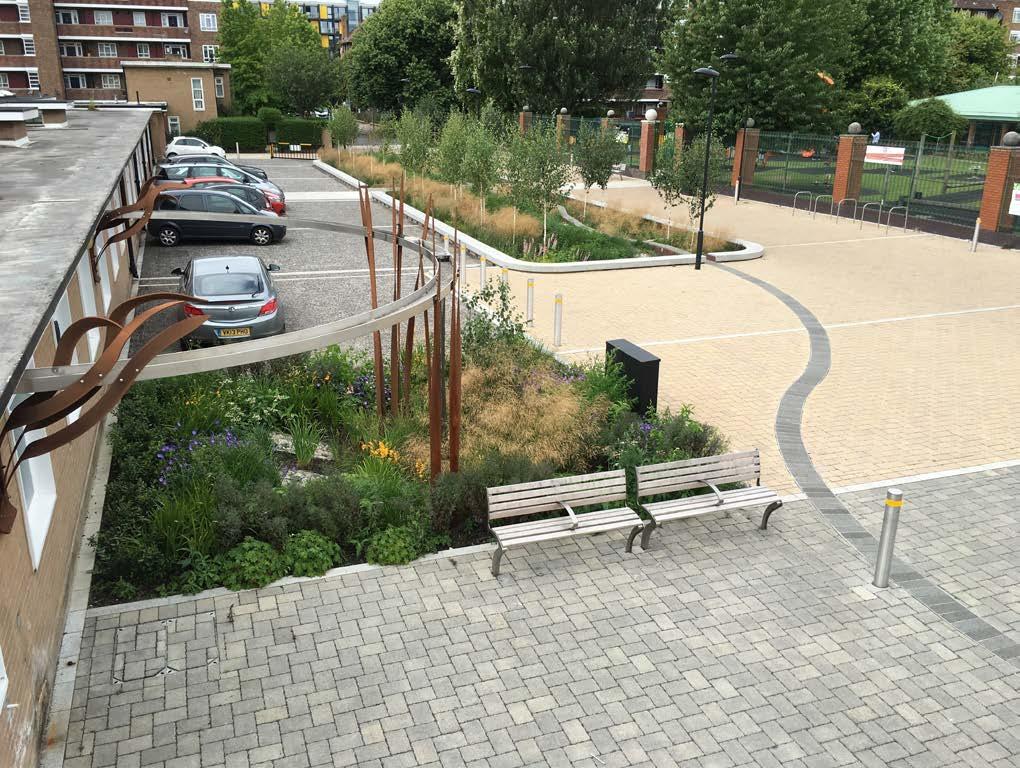

Permeable paving provides the starting point for sustainable surface water drainage or ‘SuDS’, in line with current legal requirements. And this applies equally to refurbishment and upgrade projects as well as new schemes – the trade association Interpave explains.
Concrete block permeable paving (CBPP) is a uniquely flexible SuDS (sustainable drainage systems) technique. It provides an inherent drainage system that requires no additional land take for water storage, treatment or conveyance, and offers the same visual richness as conventional block paving.
There is a growing choice of concrete blocks and paving slabs available from Interpave manufacturers, designed specifically for permeable paving. Essentially, they have the same impressive performance as conventional precast concrete paving products, being slip resistant, durable, strong and sustainable. And today there are more shapes, styles, finishes and colours than ever to give real freedom of choice. This technology also eliminates pipework, gulleys and manholes, and should therefore cost less than conventional drainage and paving.
Safe Surfaces The difference with permeable paving is the enlarged joints, filled with a permeable aggregate, and the materials used below the blocks, which are specifically selected to accommodate water. Concrete block permeable paving can be laid level and still avoids puddles without the need for drainage gulleys. It also provides a safe, firm surface for everyone – including wheelchair users and people pushing prams – unlike gravel and other loose materials.
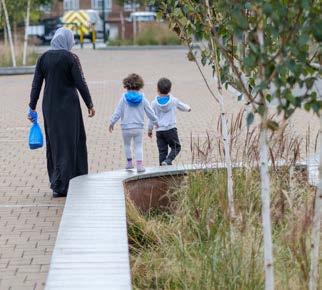
Permeable paving is specifically designed for a dual role, acting as the drainage system as well as supporting people and vehicles. At the same time, many pollutants are substantially removed and treated within the paving layers before the water leaves it. As a result of its unique capabilities, CBPP offers designers the exciting potential of a gradual supply of treated water that can be integrated with landscape design and promotes biodiversity. It provides clean water at the head of the ‘SuDS management train’ enabling safe, open SuDS features on the surface downstream.

Recent Research The importance of this was highlighted in a 2019 report by the Greater London Authority which pointed out that pollution from vehicles (including electric) is being washed off impermeable surfaces into dedicated ‘surface water’ sewers (which do not flow to sewage treatment plants), then affecting watercourses and rivers. Of course, gulleys and piped drainage do not remove pollution or attenuate water flows.
Issues such as this have already been recognised by changes to planning ‘Permitted Development’ rules for new or replacement paving around existing homes and various non-domestic buildings. Before these changes, paving anywhere in a garden or within various non-residential properties, using any materials, was considered to be ‘permitted development’. But these rights have been taken away unless permeable paving or other permeable solutions within the property are used.
Otherwise planning permission is required for new or replacement paving which is not SuDS compliant. With national and, increasingly, local planning policies encouraging or
Finally, two flow control chambers on outlets from the basins protect the combined sewer. Thus, rainfall remains within the SuDS landscape until storms have passed and the sewer can deal with water again.
requiring SuDS, such applications may well be rejected. For example, the Draft London Plan says that: ‘Development proposals for impermeable paving should be refused where appropriate, including on small surfaces such as front gardens and driveways’. This stance is supported by the 2019 National Planning Policy Framework.


Exemplary Paving An award-winning, exemplary landscape and SuDS scheme, Bridget Joyce Square in White City, London, demonstrates the multifunctional benefits of retrofitting permeable paving in place of conventional surfaces – not only on adopted streets (as here) but also drives, parking and other external areas. Its design, by Robert Bray Associates, introduces the innovative concept of concrete block permeable paving as a thin overlay for existing streets, removing rainwater straight from the surface without gulleys and providing attenuation and treatment before discharging to adjacent, well-planted basins.
The concrete block permeable paving overlay simply replaces a tarmac road surface over the original road base. The same blocks and 2-6mm grit bedding layer and jointing material as used in CBPP generally are here installed over a geo-composite conveyance sheet that transports water horizontally, on an impermeable membrane covering the road base. Water is attenuated and treated within the paving, then released horizontally via the stainless-steel letterbox slots into the planted basins.
Winner of Winners The scheme won ‘Winner of Winners’ (the President’s Award) as well as Winner of the ‘Adding Value through Landscape’ category at the 2017 Landscape Institute Awards, and also an ICE London Civil Engineering Award in 2016. But most importantly, it has been enthusiastically welcomed by local residents, as recognised by a Sustrans community survey.
A case study on the project can be downloaded from www.paving. org.uk. Here, you will also find Interpave’s essential document – ‘Design and Construction of Concrete Block Permeable Pavements’ Edition 7. This guidance aims to ensure that CBPP delivers predictable, robust solutions and to minimise cost, maintenance and adoption issues. Another new Interpave guidance document, ‘Detailing Permeable Paving & SuDS with Precast Concrete Products’, is also available demonstrating how precast concrete paving products from Interpave manufacturer members play important roles in SuDS ranging from complete permeable pavements to standard components helping other SuDS techniques work more effectively. This document brings together a variety of construction details, demonstrating best practice to make SuDS robust and durable over the long-term.

RIGBY TAYLOR LAUNCH THE 2020 EUROFLOR BROCHURE
This 56 page, full colour, fully illustrated publication is available free on request and lists all the mixtures in the Euroflor range. Each mixtures has a dedicated page that shows at a glance, a pictorial illustration of how it looks in flower, list of species, its characteristics (germination time/flowering period/drought resistance), flowering height, pack coverage, seed composition and sowing/ flowering period.
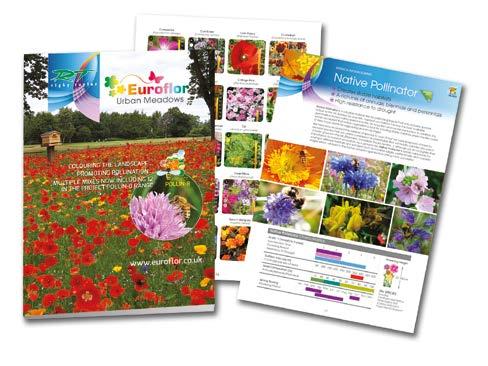
The brochure also features a section on its environmental initiative, Project Pollin-8 specifically introduced to assist in reversing the decline of pollinating insects, in particular bees. Rigby Taylor has introduced to the Euroflor seed range 12 mixtures that have been identified through information from independent research to have a longer seasonal supply of nectar and pollen to attract pollinating insects……as well as providing highly visual and attractive displays of season long colour,

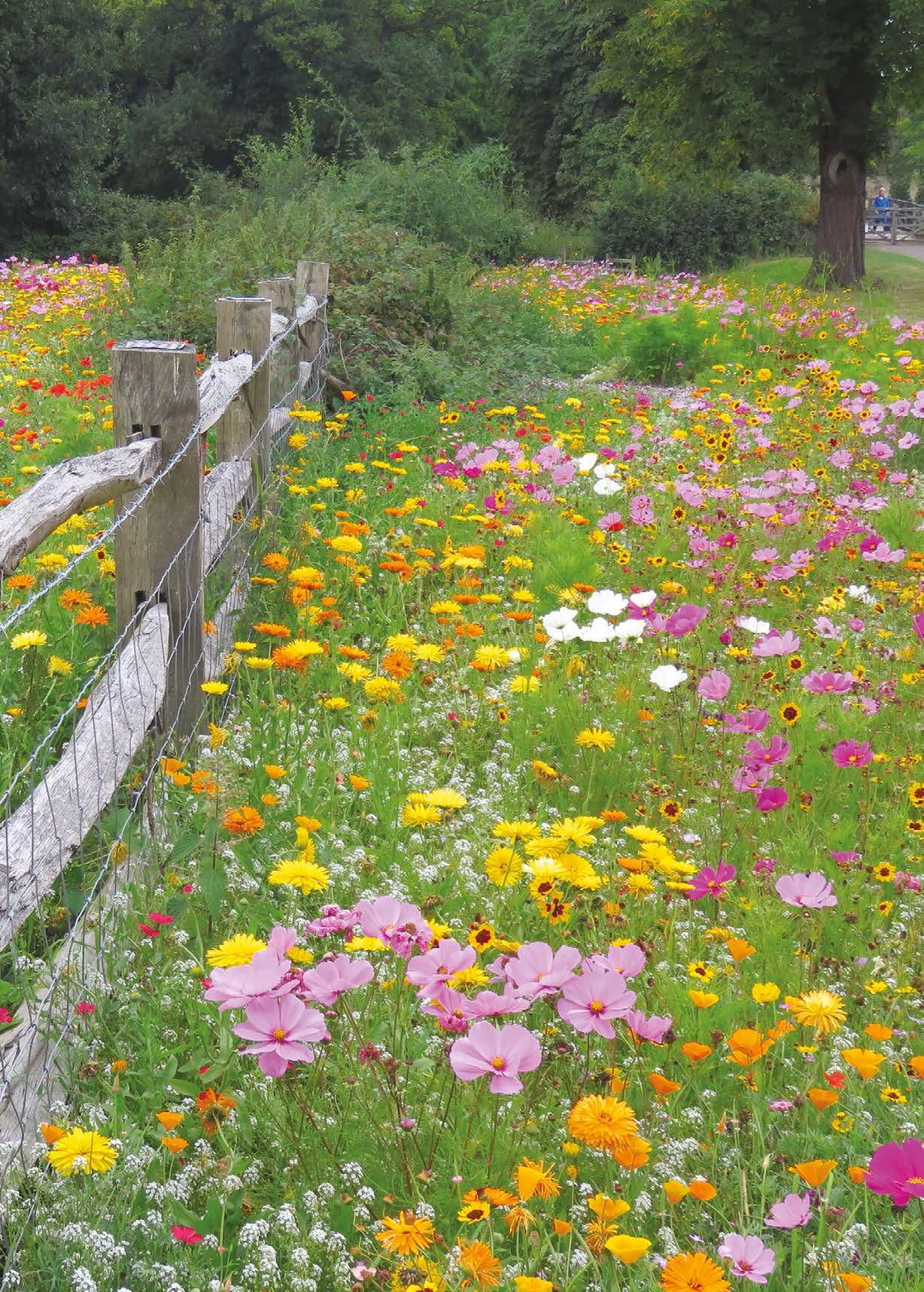
In addition, the brochure contains a technical guide to site selection soil and seed bed preparation, seed sowing, maintenance specifications and troubleshooting. It also features testimonials from organizations who

New for 2020

have discovered the benefits of sowing Euroflor urban meadows. One such organization, Monmouthshire County Council undertook an independent study of their experiences and a Case Study is available on request.
An essential part of the brochure is the Identiflower section that displays and lists, both in their Latin and common names, all the individual species contained in the Euroflor mixture range. This listing allows the reader to identify and select those mixtures with the colour and growth characteristics required.
All this information is available on the dedication Euroflor website, www.euroflor.co.uk
Superior quality designer meadows from seed and PMTurf based on 20 years of research and development
Magic Meadows™ Introducing...
by Pictorial Meadows
An expertly balanced mix of annuals, biennals, and perennials
Dramactic changes in colours and variety from year to year
Choose from 3 stunning new meadow designs
01142 677 635 PictorialMeadows.co.uk Request your catalogue or arrange your CPD now:
Meadow seed and PMTurf™supply Training and CPD seminars Design and consultation Meadow installation
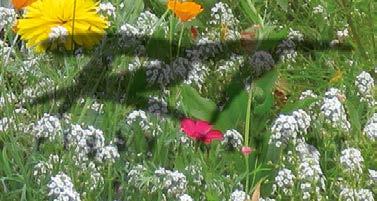
Spring sowing for summer showing


Your Spring Collection Select from over 30 mixtures including, Banquet, Boulevard, Cornflowers, Classic, Colour Bouquets, Endurance, Flora Britannica, Fragrant Lawn, Ground Cover, Honey, Sarah Bouquet, Summer Lace, Super Blue Bee, Tudor Scent ✿ Combination of mixtures provides extended period of flowering from early/mid summer through to first frosts of autumn. ✿ First flowers appear approximately 50-55 day s after sowing ✿ An extensive range of colours, heights and growth habits ✿ Provides season long supply of nectar and pollen ✿ Choose a combination of 50g packs in the Discovery box selection or 1 kg packs of a single mixture An Ecological Initiative Project Pollin-8 is a Rigby Taylor initiative to help arrest the decline on the UK bee population. Crucially, springtime flowers provide an earlier seasonal supply of energy-rich nectar and pollen, sustaining pollinators when resources are most scarce. For more information on ALL the mixtures, flower species, site selection, sowing rates and testimonials, log onto: www.euroflor.co.uk




CHAPTER HOUSE EXCLUSIVE INTERVIEW WITH ANDY STURGEON BY ANYA COOKLIN-LOFTING



Covent Garden is one of London’s most celebrated cultural neighbourhoods. Of late, this pocket of London has become a world famous destination for fashion, culture, food and theatre lovers. Covent Garden is lesser known, however, for its capacity for residential living, and even less so, for its garden space. In fact, the garden space within the residential enclave that is Chapter House, the newest development by lifestyle-led property developer, Londonewcaste, is what makes it quite so appealing.
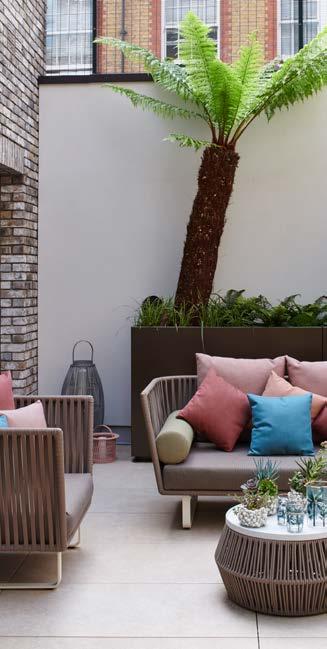
The majority of the 40 apartments at Chapter House feature generous outdoor space. The terraced spaces were created by Chelsea awardwinning landscape and garden design firm, Andy Sturgeon Design, whom I speak to today about his brief, inspirations and solutions for city gardens to tend, use year-round and enjoy. ANYA COOKLIN-LOFTING: What was your brief for the design schemes at Chapter House? What were the specific requirements that you needed to fulfil?
ANDY STURGEON: My design team and I were appointed to design a number of small terraces, gardens and a mews for the Chapter House Project. The concept for the development was to express different planting styles based on the floor levels and micro climates of the terraces. The spaces were designed to have movement. From lush green planting in the basement to sun-loving perennial planting on the top level.
ACL: How do you visualise your schemes? In terms of shapes, the sensible experience of the space or the practical uses? AS: Each space I design is carefully analysed in terms of sunlight and shading, views, how people use the space, what the demographic of the user would be and the existing landscape conditions. We then take briefs from the clients and prepare concept documents which summarise and consider all the analysis. This would also be the stage at which we present the strong concept idea to move forward with.

ACL: What plants did you specify for the Chapter House gardens, and why?
AS: The plants we chose were specified to fit the aspect of the terraces and gardens. The shadier gardens included shade tolerant species such as Dicksonia Antarctica, Libertia Grandiflora and Nandina Domestica. The sunnier spaces at the top of the development include species such as Amelanchier Lamarkii, Cistus and Pennisetum Alopecuroides Hameln.




ACL: How do you tackle the small space issue inherent to city gardens?
AS: Smaller spaces always require more creative thought. The smaller roof terraces demanded more creativity in terms of our use of space, planning, materials, planting and screening. Using light colour paving and a more reflective surface for the planters gave a greater sense of light and space to the terraces.
ACL: The raised planters feature widely across each garden space at Chapter House. Talk me through them…
AS: The raised planter boxes feature widely and are a key to the overall design scheme. They are highly contemporary, which is what we liked about them. The steel planters are powder-coated in a bronze finish to coordinate with the metal work in the building’s architecture.

ACL: And finally, can you cite any specific inspirations for the Chapter House project?
AS: The inspiration for these city gardens truly does lie in the structure of the floor levels and how we could play with diverse planting at each architectural stage. The micro climates of each of the terraces were very influential in their specific and distinct designs, each achieving a different planting character.










